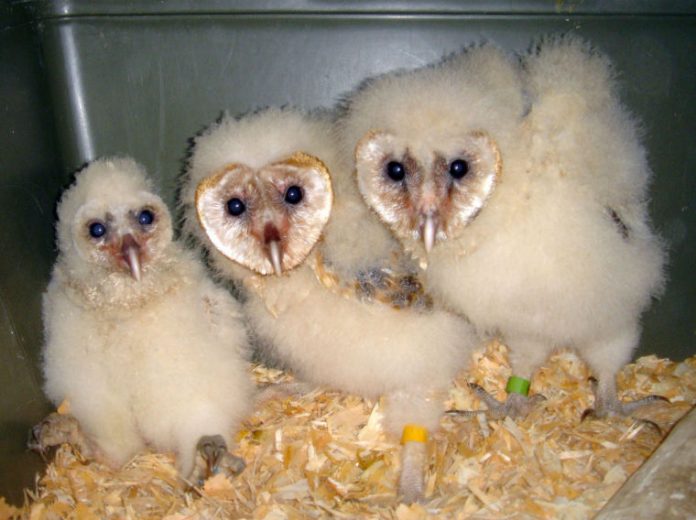March 20 heralds the arrival of spring and nature is blooming with new life, both floral and faunal. Nesting season also begins and typically continues through August. Unfortunately, every year the Wildlife Education and Rehabilitation Center and other wildlife rehabilitation facilities across the nation receive thousands of baby birds, rabbits and tree squirrels because they have lost their nests or been injured due to yard and home maintenance, such as these three little barn owlets who were knocked out of their nest in a palm tree that was being pruned.
Even trimming trees around the nests can be detrimental, not only because noise and human activity can scare away the parents, but because the nest’s covering may be lost, exposing the babies to predators and the hot sun, wind and inclement weather. Be patient and wait until the babies have hatched, fledged and flown away before you begin tree trimming, construction work, hauling, yard and lawn maintenance, or roofing. And don’t forget to check the grass or fields before you begin mowing, rototilling or weed-whacking – momma rabbit often hides her baby bunnies in the grass.
If you’re bothered by the messy droppings left by swallows who have built mud nests under your roof eaves, wait until the nests are abandoned before washing them off, then prevent the birds from returning by putting up netting. On the other hand, consider the case of the 18 tiny cliff swallows whose nests were hosed off (illegally) at a local building, but fortunately were rescued and brought to WERC. Leaving them alone would have been a boon to the owners. Adults of a colony can consume 800 flying insects a day just for their survival, and need to capture an equal amount or more to feed their offspring, helping rid the area of those pesky insects that bug us.
It is against state and federal laws to remove, destroy or disturb most nesting wild birds, their nests or their eggs, and it’s illegal to destroy the nests of tree squirrels. Special government permits are required to remove occupied nests and are only justified for a strongly compelling reason, for example, when the location creates a health hazard to humans. These laws apply to homeowners, contractors and businesses alike and violators may be prosecuted and be assessed stiff fines.
If a nest does inadvertently fall down, try to carefully place it in another part of the tree, then watch (from a distance) to see if the parent returns within four hours to care for its young. If it doesn’t, call WERC or your nearest licensed wildlife rehabilitator for advice.
As people venture out in the warm spring weather to enjoy their backyards and parks, the chances of encountering wildlife is increased. Often, well-intentioned people mistakenly believe that a wild baby is orphaned and too quickly “rescue” it. More than 75 percent of young animals rescued really do not need assistance and are being well cared for by their parents.
• If you find that a nestling (a bird that is featherless or feathers just starting to come in) is out of the nest, the best thing to do, if conditions allow, is to place the bird back into its nest.
• If you see a fledgling (bird that has feathers with a little bit of down) on the ground, unless it is injured, leave the bird alone. A fledgling has left the nest but its parents will continue to care for it until it is capable of flight and beyond.
• Some animals, such as deer and rabbits, hide their babies from predators but remain nearby. Mother rabbits feed only in the morning and at dusk. “Orphaned” wild rabbits are notoriously difficult to rehabilitate and only 10 percent will survive to be released. Other young animals may appear vulnerable but are actually self-sufficient. Leave healthy young wildlife where you find them unless they are in imminent danger.
A young animal’s best chance for survival is to be raised by its natural parents. It is important to make every effort to try to return the young to its family. Only after all efforts to reunite them have been exhausted should the orphan be removed from the wild and taken to a licensed wildlife center. Do not try to raise the baby yourself. Proper care and nutrition are crucial to the survival of the baby and a nutritional deficiency can occur within a few days and cost the animal its life. Each animal species and age has its own dietary requirements. An inappropriate diet can kill the animal. Laws protect nearly all wild birds and mammals and it is illegal to care for them without special permits.
If you’re unsure of whether an animal is in danger or if you have any questions pertaining to local wildlife, contact the Wildlife Education and Rehabilitation Center at (408) 779-WERC or visit www.werc-ca.org.










